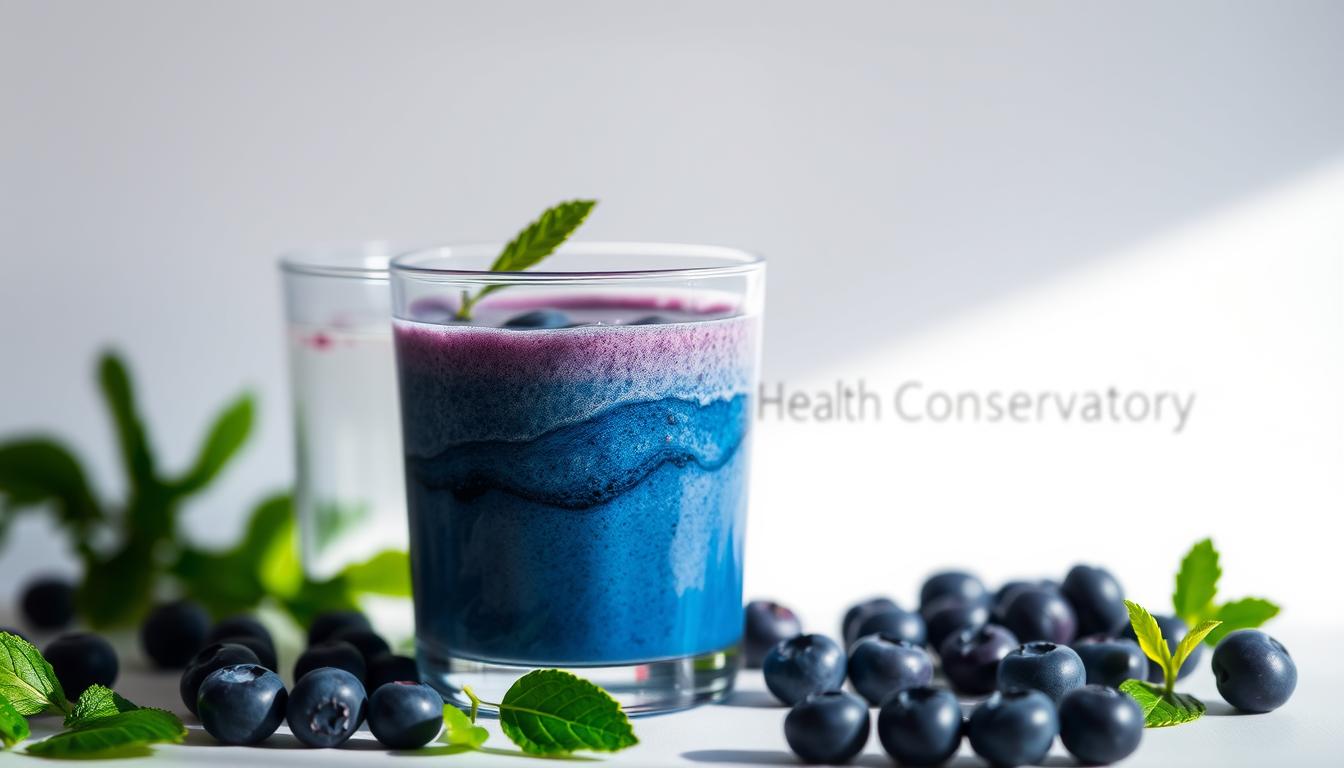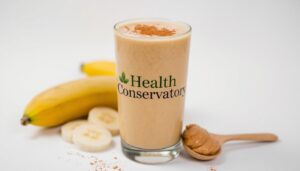How Many Calories in a Blueberry Smoothie is the first thing you want to know, and the quick answer is 240 calories per homemade serving when you blend fruit, juice, and nonfat yogurt.
This one-serving blend totals about 330 g and packs roughly 88% carbs, 4% fat, and 9% protein. It also delivers 5 g fiber, 740 mg potassium, and key vitamins like vitamin C and B6.
If you follow a vegan diet, you can swap nonfat yogurt and honey for plant-based yogurt and maple or agave to keep a similar calorie profile and creamy texture. The three choices that change your count most are liquid amount, sweeteners, and banana size.
Curious whether you can match that 240-calorie target while boosting protein? Try our free Smoothie Generator to personalize serving size and nutrients: https://healthconservatory.com/smoothie-generator
Key Takeaways
- The baseline answer: 240 calories per homemade serving (about 330 g).
- Serving size matters — one blend equals about 11.6 ounces.
- Vegans can match calories with plant yogurt and liquid swaps.
- Main calorie drivers: liquid, sweeteners, and banana size.
- Use the Smoothie Generator to customize your targets quickly.
How Many Calories in a Blueberry Smoothie: Quick Answers for Vegans
Vegans can hit the same 240-calorie target with simple swaps that keep texture and protein similar.
At a glance: 240 calories per homemade serving
One homemade serving (about 330 g or 11.6 oz) provides roughly 240 calories. The mix is carb-forward, offering quick energy for your day.
What counts as a serving right now
Use one 330 g pour as your standard serving. That yield comes from the base recipe: 1/4 cup orange juice, 1/2 tbsp honey, 1 medium banana, 1/2 cup unsweetened frozen blueberries, and 1/4 cup nonfat yogurt.
Macronutrients and Daily Value highlights you care about
The macro split is about 88% carbs, 4% fat, and 9% protein. You also get 5 g fiber (~19% daily value), 740 mg potassium (~16% DV), and vitamin B6 (~41% DV).
- Protein: modest from yogurt; swap to soy yogurt to keep it vegan-friendly.
- Fiber: 5 g helps fullness and digestion.
- Advice: use unsweetened plant milk to trim sugars and add protein.
| Metric | Per Serving | Vegan Swap |
|---|---|---|
| Calories | 240 | Maintain with 1/4 cup unsweetened soy yogurt |
| Protein | 9% of calories (~9 g) | Fortified soy milk or soy yogurt keeps protein similar |
| Fiber | 5 g (19% DV) | Add extra blueberries or frozen cauliflower for thickness |
Quick tip: For fast personalization, plug your plant yogurt and milk into the Smoothie Generator and lock the serving and calories you want: https://healthconservatory.com/smoothie-generator.
What changes the calories in your blueberry smoothie?
Your liquid base, sweetener choice, and banana size are the fastest levers for changing the nutrition profile.
Ingredients that move the needle: juice, sweeteners, and banana size
Orange juice raises carbs and natural sugars quickly. Unsweetened soy or almond milk keeps the blend lighter and shifts protein and fat slightly.
Added sweeteners add carbs but not much nutrition. Use a ripe banana or extra berries for sweetness without extra syrups. Ice or frozen veggies add volume without adding fat.
Dairy yogurt vs. plant-based yogurt: calories, protein, and fat compared
Plain soy yogurt gives more protein with modest fat. Coconut or almond styles often add more fat and less protein.
Advice: choose fortified plant milks and unsweetened yogurt to boost calcium and vitamin D while keeping value for your calories.
| Change | Effect | Vegan tip |
|---|---|---|
| Liquid base | Alters carbs and calories | Use unsweetened soy milk to lower carbs and add protein |
| Sweetener | Increases carbs fast | Ripe banana or extra berries instead of syrup |
| Yogurt type | Changes protein and fat | Pick soy yogurt for higher protein and lower fat |
How Many Calories in a Blueberry Smoothie across recipes and cafes

Serving size and recipe choices explain why similar blueberry drinks can range from light to calorie-dense.
Homemade baseline
Homemade blueberry smoothie: about 240 calories for a 330 g (11.6 oz) serving built from fruit, orange juice, and nonfat yogurt.
Nutrition snapshot: 5 g fiber (~19% daily value), mostly carbs, ~4% fat, and ~9% protein. Vegans can swap soy yogurt and maple to hold the value steady.
Lower-calorie recipe
Johns Hopkins blueberry-banana: ~122 calories per serving when split from a recipe that uses 1 cup skim milk, 1 banana, and 1/2 cup frozen blueberries.
This version packs ~5 g protein, 0 g fat, 24 g carbs, and 3 g fiber. Use soy milk to keep it vegan and preserve protein without adding fat.
Cafe comparison
Tropical Smoothie Cafe Blueberry Bliss: a 24 fl oz cup runs about 340 calories with 0.5 g fat, 86 g carbs, 4 g fiber, and 1 g protein.
Size and juice-forward bases explain the higher total compared with smaller homemade pours.
Reading labels and portion tips
- Check ounces, not just “serving,” so you compare true portion value.
- Scan calories, total carbs, fiber, protein, and fat together to judge nutrient balance.
- If you want more protein with little extra fat, add soy yogurt or a pea/soy protein scoop and cut sweetener.
- Keep at least 1/2 cup blueberries plus some banana to preserve fiber and body.
“Compare total ounces and macros to know whether the café pour matches your goals.”
| Recipe | Calories | Fat | Fiber |
|---|---|---|---|
| Homemade (330 g) | 240 | ~4% of calories | 5 g (19% daily value) |
| Johns Hopkins (per serve) | 122 | 0 g | 3 g |
| Tropical Smoothie Cafe (24 fl oz) | 340 | 0.5 g | 4 g |
Practical shortcut: use the Smoothie Generator to set your ounces, calories, and macros before you blend. It helps you match café favorites while staying plant-forward and portion-controlled: Smoothie Generator.
Conclusion
The short answer: most homemade pours land near 240 calories for a 330 g serving, while lighter recipes can be ~122 per serving and café pours may reach ~340 for larger cups.
For your vegan swaps, choose plant-based yogurt and unsweetened fortified milks, trim sweeteners, and size your banana and liquid to match the goal. This keeps texture and protein without excess sugars or fat.
Keep nutrition front of mind: pair berries with soy yogurt or a pea/soy protein scoop to boost protein and fiber so your drink sustains you.
Ready to personalize? Lock your ingredients, portion, and target on the Smoothie Generator before you blend: https://healthconservatory.com/smoothie-generator




